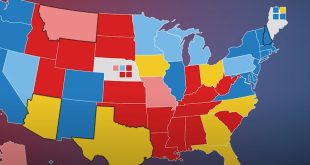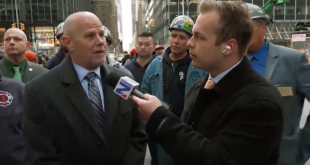It cost more than $160 million for Gov. Ron DeSantis of Florida to come in second place in a single nominating contest.
That astounding sum makes Mr. DeSantis’s failed presidential bid among the most expensive in modern Republican primary elections. But the details of where the money went, laid out in filings to the Federal Election Commission on Wednesday, show just how free-spending Mr. DeSantis and his allied super PACs were.
They directed at least $53 million through firms controlled or owned by Jeff Roe, the powerful Republican strategist who served as the top adviser to Never Back Down, Mr. DeSantis’s main super PAC.
They spent $31.3 million on television advertising time.
They spent at least $3.3 million on private airfare, between the campaign and Never Back Down.
And they donated roughly $110,000 to the campaigns of state and federal elected officials who had endorsed Mr. DeSantis.
All for 23,420 votes in Iowa.
The bulk of the money — $130 million — was spent by Never Back Down. The super PAC was supposed to be Mr. DeSantis’s secret weapon in his quest to take down former President Donald J. Trump, including through an ambitious canvassing operation built to knock on the doors of DeSantis supporters as many as five times. His campaign spent an additional $28 million.
The enormously costly effort produced negligible results, and Mr. DeSantis decided to drop out before the New Hampshire primary and endorse Mr. Trump. But it did test the limits of campaign finance law.
Never Back Down took an unprecedented role in managing Mr. DeSantis’s campaign, even though campaigns and super PACs are not allowed to coordinate their strategies. Mr. DeSantis handed over many duties traditionally overseen by campaign officials — like arranging events and organizing get-out-the-vote efforts — to the outside group.
The awkward arrangement left key decisions in the hands of super PAC leaders, rather than Mr. DeSantis’s tight circle of trusted advisers. Tensions between Never Back Down and the campaign generated flurries of negative news stories that sometimes overshadowed Mr. DeSantis’s candidacy, particularly among wealthy donors.
Representatives for the DeSantis campaign and Never Back Down did not respond to requests for comment. Neither did Mr. Roe.
Mr. DeSantis was not the only Republican candidate this cycle to spend vast sums only to drop out. Senator Tim Scott of South Carolina entered the race with $22 million in his campaign coffers, carried over from his 2022 re-election bid. Within weeks, a super PAC backing him had raised an additional $20 million.
But by the fall, Mr. Scott’s fund-raising stream was drying up as enthusiasm for his candidacy dipped, new federal filings show. His groups spent heavily, with the campaign spending more than $30 million in all and the super PAC laying out $21.8 million, including about $15 million in advertising.
Details of his spending are hard to discern, because large chunks of the money went to two limited-liability companies with no other apparent business, based at suburban Staples stores.
In the end, Mr. Scott didn’t even make it to Iowa, dropping out in November.
The entrepreneur Vivek Ramaswamy put $25.6 million of his own money into his campaign, in loans and contributions, before departing the race after coming in fourth place in Iowa. At the end of December, his campaign had $1.5 million left. A super PAC backing him raised $8.7 million and spent nearly all of it.
Gov. Doug Burgum of North Dakota, a wealthy businessman, lent his campaign $14.8 million; the campaign spent $17.8 million before he left the race in December. A super PAC backing him raised $24.1 million and spent $24 million.
But Mr. DeSantis’s bid, and its collapse, stand out for their scale. Aside from Mr. Trump, no other candidate entered the race with more financial support, more hype or higher poll numbers.
By the time Mr. DeSantis entered the race in late May, Never Back Down had a war chest of nearly $120 million, including more than $80 million left over from Mr. DeSantis’s re-election as governor of Florida. In his first six weeks as a candidate, his campaign also raised more than $20 million. (Unlike campaigns, super PACs are allowed to accept unlimited sums of money from donors, making them a vehicle for the ultrawealthy to support candidates.)
Never Back Down planned a $100 million ground game to mobilize voters across the country, including a huge voter-outreach push that would deploy paid door-knockers to reach out to likely DeSantis voters in early nominating states. The group pledged to raise $200 million.
Warning signs soon emerged.
Mr. DeSantis insisted on flying on private aircraft, a habit he picked up during his time in Tallahassee — and an unsustainable one for a candidate who was not independently wealthy.
The campaign spent beyond its means in its opening weeks, prompting a reshuffling and deep staff cuts in July. Never Back Down, which had also been laying out large sums of money, picked up much of the slack, records show, including footing the bill for Mr. DeSantis’s flights.
Mr. Roe was a central figure in the DeSantis candidacy, and the large sum that went through his companies reflects his ambitions to run the country’s largest political consulting firm. At times, he drew unwanted publicity to the campaign, and he was also a target of mockery by Mr. Trump’s surrogates. He left the super PAC in December, as the group collapsed in turmoil.
Never Back Down also quietly sent some of its money, $2.75 million, to Win It Back, a super PAC supported by the Club for Growth, an influential conservative anti-tax group. Around the same time, Win It Back ran a series of anti-Trump advertisements. The contribution was not revealed until after Mr. DeSantis had dropped out.
While Mr. DeSantis pulled his punches against Mr. Trump for much of the campaign, the donation illustrated how super PACs can be used to do a candidate’s dirty work without leaving many fingerprints.
Win It Back eventually pulled the ads, saying it had found they were unpopular with Republican voters — a sign of the apparent futility of challenging Mr. Trump in a G.O.P. primary.
Meanwhile, another of Mr. DeSantis’s committees was used to show his apparent gratitude to several politicians who had endorsed him at the risk of drawing Mr. Trump’s ire. The group, Great American Comeback, donated more than $110,000 to those officials, including $6,600 to Representative Chip Roy of Texas, who stumped with Mr. DeSantis relentlessly in the campaign’s final weeks. More than a dozen Iowa state legislators also received contributions.
Through it all, Mr. DeSantis’s fund-raising was slowing, as his poll numbers plummeted and his shaky moments as a candidate piled up. While Mr. DeSantis had begun the race as the darling of many conservative donors hoping to move on from Mr. Trump, the Florida governor saw much of that support leak away, first to Mr. Scott and then to former Gov. Nikki Haley of South Carolina, who remains in the contest.
Mr. DeSantis’s campaign raised less and less money each quarter of 2023; Never Back Down raised just $14.5 million in the second half of the year.
Allies of Mr. DeSantis jumped in to help out, starting their own super PACs that were seeded with money from Never Back Down. The formation of the new groups, Fight Right and Good Fight, led to tensions at Never Back Down, where many top officials quit or were fired.
Fight Right and Good Fight took over television advertising while Never Back Down focused on get-out-the-vote operations, a move publicly encouraged by the DeSantis campaign.
The two new super PACs spent $13.8 million on television advertisements in Iowa. Much of their money came from transfers from Never Back Down and Great American Comeback while just a fraction came from donors, mainly wealthy Floridians loyal to Mr. DeSantis, as well as CDR Enterprises, a major state contractor.
By the end of 2023, Never Back Down had spent every penny of the $120 million in its coffers when Mr. DeSantis began his candidacy, and then some.
Three weeks later, Mr. DeSantis was out of the race.
 Top Naija News: Nigerian News, Breaking News Nigeria and World News Top Naija News is a daily news publication in Nigeria, delivering the latest breaking news in Nigeria and around the world.
Top Naija News: Nigerian News, Breaking News Nigeria and World News Top Naija News is a daily news publication in Nigeria, delivering the latest breaking news in Nigeria and around the world.



